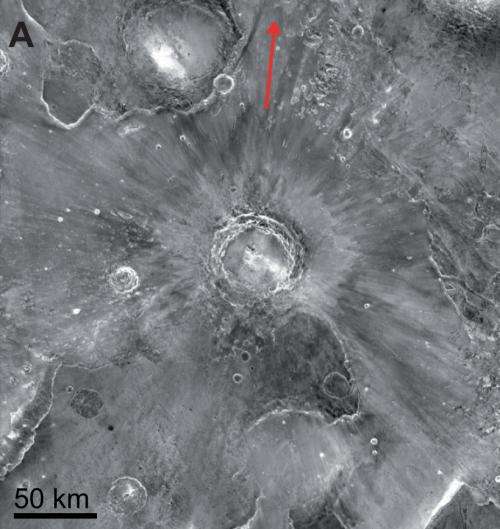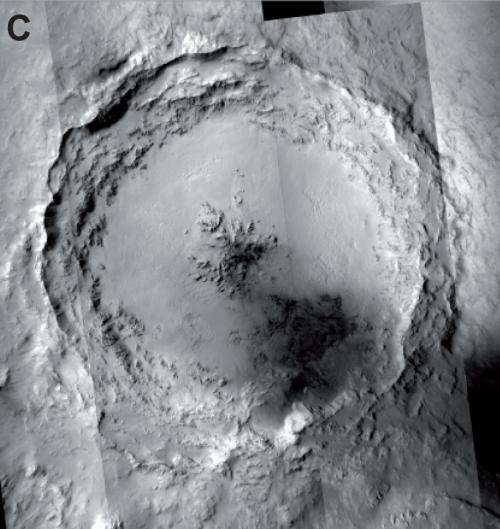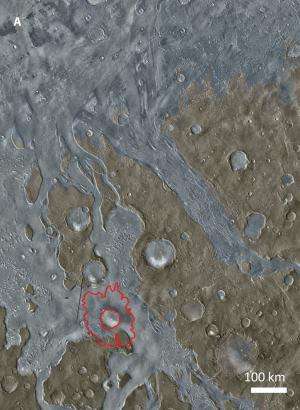March 7, 2014 report
Researchers claim Mojave Crater on Mars is source of Mars rocks found on Earth

(Phys.org) —A trio of researchers, two from France and one from Norway, has published a paper in the journal Science where they claim to have found sufficient evidence to identify a specific crater on Mars as the origin of Mars rocks found on the Earth's surface. In their paper Stephanie Werner, Anouck Ody and François Poulet describe their extensive research and how they came to their conclusions.
Scientists have known for many years that some of the meteorites that strike the Earth came from Mars. Such rocks are ejected from the surface of Mars when struck by meteorites themselves. Mars rocks have been classified into three main categories depending on their chemical makeup: chassignites, nakhlites and shergottites. The latter make up roughly three quarters of all such rocks found and have been studied extensively over the years. In this new effort, the researchers contend that all shergottites come from a single source on Mars: Mojave Crater.
To establish Mojave Crater as the source, the researchers combined several types of data, each of which suggest the crater as a likely suspect, though there is one, the estimated age of the rocks, that is not quite as clear-cut as the others.

The researchers began by analyzing imagery of Mars surface taken by various spacecraft over the years—they were looking for reasonably recent formation, a large size and rays leading away from the crater indicating a blast capable of sending rocky debris into space. Mojave Crater stood out as one of the best candidates for further study. The team next examined data gathered by spacecraft that have orbited the Red Planet over the years, specifically those that had taken mineral scans (measures of wavelengths of light bounced back off of them) of the Mojave Crater and the area around it. Analysis showed that the mineral composition of rocky material on the lip of the crater matched closely with the Mars rocks found on Earth. The team also sought to determine the age of the crater by studying the surface area around it—the number of craters around it and their size allows for a model to be made based on techniques developed with the Apollo moon project. Their study showed that the crater was likely formed approximately three million years ago. Finally, prior research has shown that the Martian rocks likely were in transit on average less than five million years, based on cosmic ray exposure.

Prior research has shown that the plateau in which Mojave Crater exists is approximately 4.3 billion years, which suggests that rocks blasted from its surface should be near the same age. Unfortunately, that's where things don't match as well. Most studies of Mars rocks have found them to be only 150 to 600 million years old. The researchers suggest this anomaly can be explained by events (shock waves, etc.) that transpired on Mars that set their age clock back.
More information: The Source Crater of Martian Shergottite Meteorites, Science DOI: 10.1126/science.1247282
ABSTRACT
Absolute ages for planetary surfaces are often inferred by crater densities and only indirectly constrained by the ages of meteorites. We show that the <5 million-year-old and 55-km-wide Mojave Crater is the ejection source for the meteorites classified as shergottites. Shergottites and this crater are linked by their coinciding meteorite ejection ages and the crater formation age, and mineralogical constraints. Because Mojave formed on 4.3 billion year old terrain, the original crystallization ages of shergottites are old, as inferred by Pb-Pb isotope ratios, and the much-quoted <600 million years shergottite ages are due to resetting. Thus, the cratering-based age determination method for Mars is now calibrated in situ, and shifts the absolute age of the oldest terrains of Mars backward by 200 million years.
Journal information: Science
© 2014 Phys.org





















